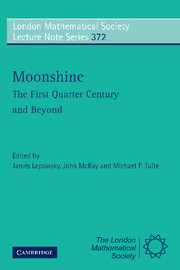 Moonshine - The First Quarter Century and Beyond
Moonshine - The First Quarter Century and Beyond Book contents
- Frontmatter
- Contents
- Preface
- Schedule of Talks
- Characters of Crossed Modules and Premodular Categories
- On the Injectivity of the Kudla-Millson Lift and Surjectivity of the Borcherds Lift
- Ordered Spanning Sets for Vertex Operator Algebras and their Modules
- Friendly Giant Meets Pointlike Instantons? On a New Conjecture by John McKay
- Modularity of Trace Functions in Orbifold Theory for ℤ-Graded Vertex Operator Superalgebras
- Twisted Modules for Vertex Operator Algebras
- Vertex Operators and Sporadic Groups
- The Algebraic Meaning of Being a Hauptmodul
- Borcherds' Proof of the Conway-Norton Conjecture
- On the Connection of Certain Lie Algebras with Vertex Algebras
- Vertex Operators and Arithmetic: How a Single Photon Illuminates Number Theory
- Rational Vertex Operator Algebras and their Orbifolds
- Quasi-finite Algebras Graded by Hamiltonian and Vertex Operator Algebras
- On Certain Automorphic Forms Associated to Rational Vertex Operator Algebras
- Moonshine and Group Cohomology
- Monstrous and Generalized Moonshine and Permutation Orbifolds
- New computations in the Monster
Preface
Published online by Cambridge University Press: 06 July 2010
- Frontmatter
- Contents
- Preface
- Schedule of Talks
- Characters of Crossed Modules and Premodular Categories
- On the Injectivity of the Kudla-Millson Lift and Surjectivity of the Borcherds Lift
- Ordered Spanning Sets for Vertex Operator Algebras and their Modules
- Friendly Giant Meets Pointlike Instantons? On a New Conjecture by John McKay
- Modularity of Trace Functions in Orbifold Theory for ℤ-Graded Vertex Operator Superalgebras
- Twisted Modules for Vertex Operator Algebras
- Vertex Operators and Sporadic Groups
- The Algebraic Meaning of Being a Hauptmodul
- Borcherds' Proof of the Conway-Norton Conjecture
- On the Connection of Certain Lie Algebras with Vertex Algebras
- Vertex Operators and Arithmetic: How a Single Photon Illuminates Number Theory
- Rational Vertex Operator Algebras and their Orbifolds
- Quasi-finite Algebras Graded by Hamiltonian and Vertex Operator Algebras
- On Certain Automorphic Forms Associated to Rational Vertex Operator Algebras
- Moonshine and Group Cohomology
- Monstrous and Generalized Moonshine and Permutation Orbifolds
- New computations in the Monster
Summary
In 1979 John Conway and Simon Norton published their famous paper entitled “Monstrous Moonshine.” This paper greatly expanded on earlier observations and ideas of John McKay and John Thompson and on an observation of Andrew Ogg stimulated by a lecture of Jacques Tits on the conjectured Fischer-Griess Monster sporadic finite simple group. The paper presented a number of conjectures relating the conjugacy classes of the Monster to certain meromorphic modular invariant functions, called Hauptmoduln (= principal moduli), for a particular set of genus zero modular groups. The search for an explanation of this remarkable connection between finite group theory and number theory involved the development and application of many diverse areas of mathematics including vertex (operator) algebras, Borcherds algebras, or generalized Kac-Moody algebras, automorphic forms and elliptic cohomology, together with string theory and conformal field theory in theoretical physics. Robert Griess constructed the Monster; Igor Frenkel, James Lepowsky and Arne Meurman constructed a “Moonshine Module” for the Monster by means of vertex operator theory, proving the McKay-Thompson conjecture; and Richard Borcherds proved the remaining Conway-Norton conjectures for the Moonshine Module, which carries the structure of a vertex operator algebra. Many new problems remain — problems that could not even have been formulated in 1979.
To mark the 25th anniversary of the publication of the Monstrous Moonshine paper, a workshop entitled “Moonshine – the First Quarter Century and Beyond, a Workshop on the Moonshine Conjectures and Vertex Algebras” was hosted by the International Centre for Mathematical Sciences at Heriot-Watt University, Edinburgh from 5th July to 13th July in 2004 (www.icms.org.uk/archive/meetings/2004/moonshine).
- Type
- Chapter
- Information
- Moonshine - The First Quarter Century and BeyondProceedings of a Workshop on the Moonshine Conjectures and Vertex Algebras, pp. vii - ixPublisher: Cambridge University PressPrint publication year: 2010
